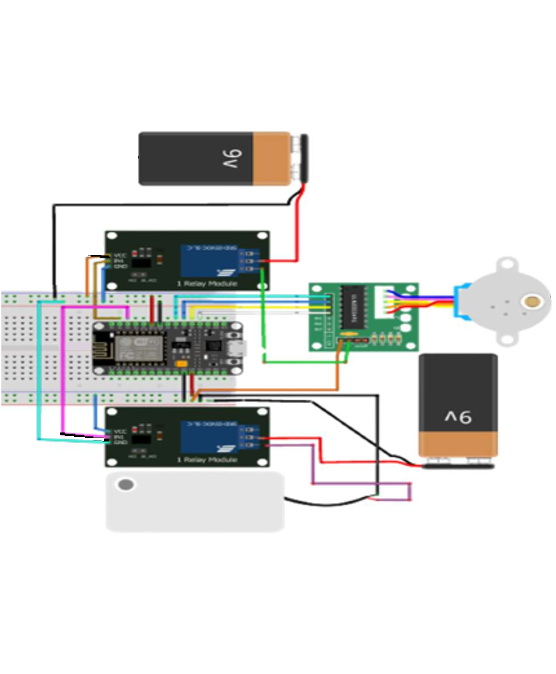Designing a Google Voice-Based Solar Panel Cleaner Control System

Downloads
Current solar panel maintenance often involves manual, rooftop fieldwork, which introduces significant fall-from-height risks and occupational hazards. To address this, this research investigates the integration of the Internet of Things (IoT) to streamline and enhance operational efficiency. The goal is to develop an IoT-enabled solution for user-driven routine maintenance that can significantly mitigate occupational hazards and reduce maintenance duration. This system is designed to optimize the long-term energy yield of solar panels by preventing the typical efficiency decline caused by neglected upkeep. The study employs a prototype development method (literature review, construction model design, and control system development). The final system leverages common consumer-grade terminal devices (smartphones, laptops) to provide a ubiquitous, real-time control interface, allowing users to manage the system remotely via a stable network connection.
Downloads
[1] M. R. W. Kusuma, E. Apriaskar, and D. Djunaidi, “Rancang Bangun Sistem Pembersih Otomatis Pada Solar Panel Menggunakan Wiper Berbasis Mikrokontroler,” Techné J. Ilm. Elektrotek., vol. 19, no. 1, pp. 23–32, 2020.
[2] M. Katoch, V. Dahiya, and S. K. Yadav, “The performance analysis of dusty photovoltaic panel,” Arch. Thermodyn., vol. 44, no. 2, 2023.
[3] C. O. Rusănescu, M. Rusănescu, I. A. Istrate, G. A. Constantin, and M. Begea, “The effect of dust depo-sition on the performance of photovoltaic panels,” Energies, vol. 16, no. 19, p. 6794, 2023.
[4] S. Yakubu et al., “A holistic review of the effects of dust buildup on solar photovoltaic panel efficiency,” Sol. Compass, vol. 13, p. 100101, 2025.
[5] S. A. Patil, A. R. Patil, V. N. Chougule, and S. T. Sanamdikar, “Design and Analysis of Automated Solar Panel Cleaning System,” Curr World Env, vol. 18, pp. 1032–1045, 2024.
[6] M. T. Akkoyunlu and Y. Abdallatif, “A comprehensive investigation of solar panel cleaning technologies: A review study,” J. Therm. Eng., vol. 10, no. 6, pp. 1715–1741, 2021.
[7] B. Rangaswamy and R. Nithya, “Advancements in solar panel maintenance: a review of IoT-integrated automatic dust cleaning systems,” Inform. Autom. Pomiary W Gospod. Ochr. Śr., vol. 15, no. 1, pp. 39–44, 2025.
[8] B. Aboagye, S. Gyamfi, E. A. Ofosu, and S. Djordjevic, “Investigation into the impacts of design, instal-lation, operation and maintenance issues on performance and degradation of installed solar photovoltaic (PV) systems,” Energy Sustain. Dev., vol. 66, pp. 165–176, 2022.
[9] S. Singarapu, K. Swaraja, and M. Kirola, “Smart Iot based solar panel cleaning system,” in E3S Web of Conferences, EDP Sciences, 2023, p. 01147.
[10] M. Ghafoor, A. A. Amin, and M. S. Khalid, “Design of IoT-based solar array cleaning system with enhanced performance and efficiency,” Meas. Control, vol. 57, no. 8, pp. 1099–1111, 2024.
[11] R. Bosch, “IoT based Smart and Automated Solar Panel Cleaning System”.
[12] A. Al-Fuqaha, M. Guizani, M. Mohammadi, M. Aledhari, and M. Ayyash, “Internet of things: A survey on enabling technologies, protocols, and applications,” IEEE Commun. Surv. Tutor., vol. 17, no. 4, pp. 2347–2376, 2015.
[13] A. K. Cherian, H. Mercy, R. Reshma, K. Sivakami, R. Krishnamoorthy, and R. Thiagarajan, “An IoT based Voice Assisted Smart Residential Appliance Control Mechanism using Intelligent Node MCU Controller,” in 2024 5th International Conference on Electronics and Sustainable Communication Systems (ICESC), IEEE, 2024, pp. 381–387.
[14] A. Zainuddin, N. A. Zubir, N. A. Aminuddin, N. D. K. Ashar, and M. E. Mahadan, “Appliance Control with IOT-Arduino of Voice Command Detection for Mobility Impaired People.,” Int. J. Interact. Mob. Technol., vol. 15, no. 23, 2021.
[15] L. M. S. Huyer, “Improving Usability for Novices in the Design of Mechatronic Devices: A Study Using Arduino Modules,” Queen’s University (Canada), 2024.
[16] N. S. Atiyah, Development of An Industrial Atmega328p Microcontroller Based On An Open-Source Platform. University Of Kerbala, 2023.
[17] R. Pahwa, H. Tanwar, and S. Sharma, “Speech recognition system: A review,” Int. J. Future Gener. Commun. Netw., vol. 13, no. 3, pp. 2547–2559, 2020.
[18] P.-C. Lin, B. Yankson, V. Chauhan, and M. Tsukada, “Building a speech recognition system with priva-cy identification information based on Google Voice for social robots,” J. Supercomput., vol. 78, no. 13, pp. 15060–15088, 2022.
[19] P. Netinant, T. Utsanok, M. Rukhiran, and S. Klongdee, “Development and assessment of internet of things-driven smart home security and automation with voice commands,” IoT, vol. 5, no. 1, pp. 79–99, 2024.
[20] E. Akbaş, “Enhancing Incident Response with Live Logs: The Significance and Challenges of Maintain-ing Sufficient Log Retention for Mitigating Cyber Attacks,” in International Conference on Cyber Secu-rityICCYS-23, 2023.
[21] T. Magara and Y. Zhou, “Internet of things (IoT) of smart homes: privacy and security,” J. Electr. Com-put. Eng., vol. 2024, no. 1, p. 7716956, 2024.
[22] G. Vardakis, G. Hatzivasilis, E. Koutsaki, and N. Papadakis, “Review of smart-home security using the internet of things,” Electronics, vol. 13, no. 16, p. 3343, 2024.
[23] D. Mwebe, V. H. U. Eze, and B. O. Sadiq, “Impact of dust accumulation on solar photovoltaic panel performance and the efficacy of cleaning methods: A review of technological innovations and regional considerations,” 2025.
[24] D. Hameed et al., “Evaluation of self-cleaning mechanisms for improving performance of roof-mounted solar PV panels: A comparative study,” PloS One, vol. 19, no. 10, p. e0309115, 2024.

This work is licensed under a Creative Commons Attribution-ShareAlike 4.0 International License.
The Authors submitting a manuscript do so on the understanding that if accepted for publication, copyright publishing of the article shall be assigned to Journal.



















